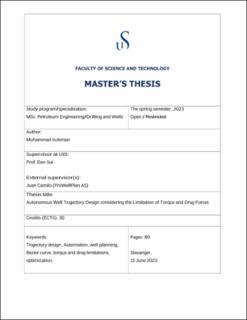| dc.description.abstract | In the oil and gas industry, designing well trajectories is an important part of drilling operations that affect well construction, completion, and production. But the current trajectory planning process works in isolation and does not take many engineering constraints into account, which leads to inefficiency, manual iterations, and less-than-ideal results. This study aims to solve the problem by making an automated system for designing 3D trajectories that uses engineering calculations and focuses on torque & drag analysis. The objectives of this research include the development of algorithms to automate and optimize trajectory design, the integration of torque and drag calculations to avoid drill string damage through buckling or over torque, and the evaluation of the system’s performance through case studies. The research also explores the kick-off point optimization and trajectory optimization between target points to enhance well placement and planning efficiency. The significance of this research lies in its potential to revolutionize well planning processes and minimize the cost associated with planning complex wells. It will help the industry by making trajectory planning easier, saving time and money, and minimizing the risks of drilling operations. | |
